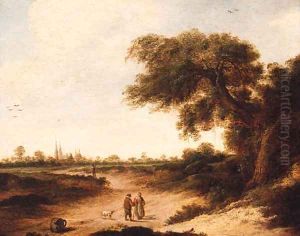Jan Vermeer Of Haarlem Paintings
Jan Vermeer van Haarlem, not to be confused with Johannes Vermeer of Delft, was a Dutch Golden Age painter who was born in 1628 in Haarlem, Netherlands. His full name was Jan Jansz Vermeer van Haarlem, and he was sometimes referred to as Vermeer of Haarlem the Elder to distinguish him from his son, Jan Vermeer van Haarlem the Younger, who was also an artist.
Jan Vermeer van Haarlem the Elder's career flourished in the city of Haarlem, where he became known for his landscape paintings and depictions of Dutch countryside life. His work is characterized by a keen attention to detail and a talent for capturing the effects of light and atmosphere. While his name is often overshadowed by his contemporary, Johannes Vermeer of Delft, who is famous for his genre scenes and masterful use of light, Jan Vermeer van Haarlem was an important figure in his own right within the regional scene of Dutch painting.
He was a member of the Haarlem Guild of Saint Luke, which was a common association for artists of the period, and he played a significant role in the artistic life of his city. His landscapes depict the flat terrain of the Netherlands, often with scenes of daily life, such as peasants working in the fields, and are noted for their realistic qualities and serene compositions.
Jan Vermeer van Haarlem the Elder passed away in 1691 in Haarlem. His legacy includes a body of work that contributes to our understanding of Dutch landscape painting during the 17th century. Although his works may not be as widely recognized as those of Johannes Vermeer of Delft, they remain a testament to the breadth and diversity of Dutch painting during its Golden Age.
